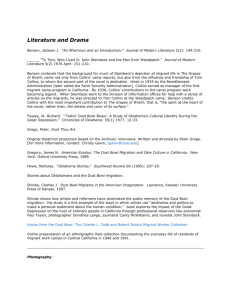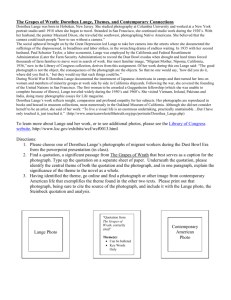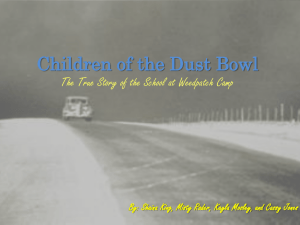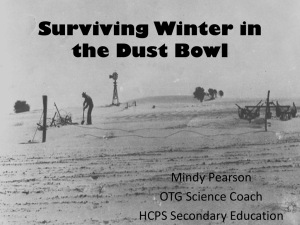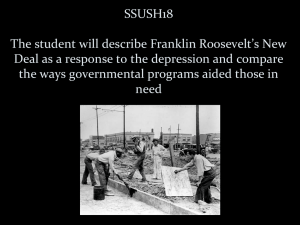Life During the Great Depression - pams
advertisement
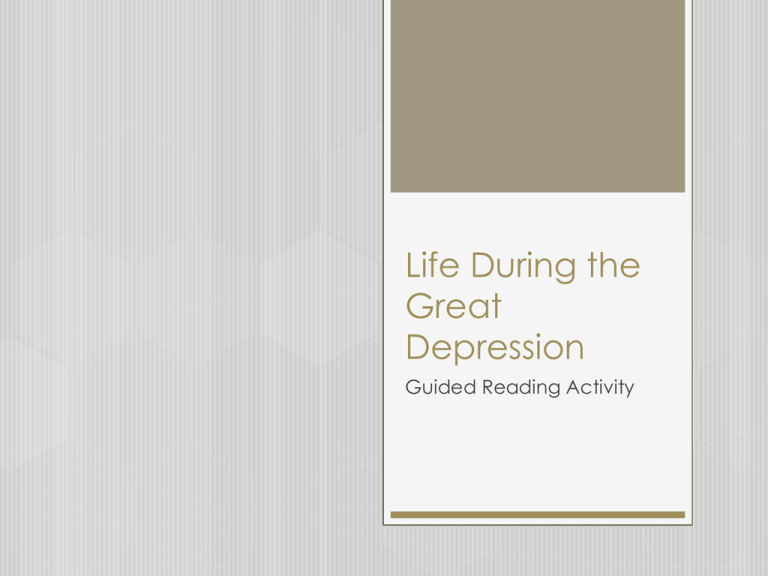
Life During the Great Depression Guided Reading Activity Women had a hard time keeping jobs during the Great Depression due to sexism and new competition. • • • Men were competing for traditional jobs in teaching and education. Since men were considered the breadwinners in society, women were expected to give their jobs to unemployed men. Domestic jobs, like the ones advertised to the left, were increasingly scarce as family budgets tightened. First Lady Eleanor Roosevelt Eleanor Roosevelt kept in constant communication with the American people by : Traveling constantly Making frequent radio speeches on topics she considered important. Writing a daily newspaper column. Eleanor Roosevelt As First Lady, Roosevelt also held exclusive press conferences for female reporters. She encouraged her husband to appoint as many women to power as possible – including the first female cabinet member, Secretary of Labor Francis Perkins. Eleanor Roosevelt supported AfricanAmerican rights, speaking in favor of antilynching laws proposed by the U.S. Congress. • • • • Low cotton prices forced African-American men to leave sharecropping jobs for industrial jobs in the cities. Southern communities usually hired poor whites – who suffered similarly – for positions before black workers. Northern Industrial jobs were given to white immigrants before African American men. Racism prevailed in both the North and the South. Civil Rights Civil Rights are the rights guaranteed in the Constitution, especially voting rights and the equal treatment under the law. During the Great Depression, the 14th and 15th Amendments to the Constitution guaranteed African-Americans civil rights in theory; however, segregation and “Jim Crow” still reigned in the South, and racism prevailed all over the United States. Roosevelt would not support antilynching laws. Although Eleanor Roosevelt supported anti-lynching laws and FDR was in favor of them in principal, the President never demanded any major Civil Rights legislation while in office. FDR always believed that forcing antilynching laws through the Congress would jeopardize his ability to work with Southern Democratic legislators. Thus, racist and murderous lynch mobs continued to murder men, and then have their portraits made next to the bodies – fearlessly since judge, jury, and lawmen were all so racist that no white man would ever be arrested, much less convicted of a crime, against an African-American. Easter Sunday at the Lincoln Memorial When the Daughters of the American Revolution forbid Mirian Anderson to perform in their concert hall because she was black, Eleanor Roosevelt resigned her membership in protest. Then, she arranged for an Easter Sunday concert featuring Mirian Anderson on the steps of the Lincoln Memorial in Washington, D.C. Over 75,000 attended. During prosperous times, California and Southwestern farmers were happy to employ Mexican immigrants to the United States – they were considered cheap labor. When the Depression and the Dust Bowl brought thousands upon thousands of white workers out west, though, Mexican laborers were no longer wanted. Now, they were deported. Reportedly, even Mexican-Americans – United States citizens of Mexican ancestry – were deported to Mexico by train. Mexican Immigrants and Mexican Americans Deported The Indian Reorganization Act of 1934 Although John Collier’s efforts to restore power to the reservations – through the construction of schools, hospitals, irrigation systems, and government structures – were genuine, they did not succeed. Collier wanted to see an interest in Native American history revived and funding for Native American arts and cultural expression. But this did not improve living conditions on reservations, which remained desperately poor. Despite restrictions on land sales, the reservations continued to be broken up and disjointed by real estate transactions. The “Indian New Deal” was unsuccessful. The Dust Bowl The Dust Bowl was caused by a variety of factors – but largely because of widespread crop failures due to drought. Modern farming methods which had removed sod from thousands of acres of land contributed to the problem as well. Without the grasslands to keep it in place, the dry soil of the Great Plains was unstable. When windstorms unaccompanied by rain began to torment the Great Plains, the powder-like soil took flight, and dust blackened the sun. A Dust Storm in Texas, 1935 An Oklahoma Dust Storm The Dust Bowl: Worst Areas The Dust Bowl: Ruined Farms The Dust Bowl: Ruined Farms Families who lost everything during the ecological disaster known as “The Dust Bowl” were forced to hit the road. They could not breathe the air, much less farm in a prosperous manner, in the Midwest. Many decided to head west, along Route-66 to California. “Okies” Emigrate The cars they drove west in were often weighed down with everything they had left in the world. Entire families crowded into the car, driving West to find work picking fruits and vegetables in California. Most would struggle for many years before they found stability and economic well-being again. “Okies” headed west on Route 66. The Grapes of Wrath, by John Steinbeck In John Steinbeck’s classic novel is about the survival of the working class American family – come what may. In the book, the Joads abandon their failed Oklahoma farm and head west. Tom Joad, an antihero who has violated parole to stay will his family, finds himself involved with the cause of social justice among the migrant workers in California. By the end of the novel, Tom is forced to leave his folks, yet the family – battered but not broken – remains. “The People” Survive “The women watched the men, watched to see whether the break had come at last. The women stood silently and watched. And where a number of men gathered together, the fear went from their faces, and anger took its place. And the women sighed with relief, for they knew it was all right – the break had not come; and the break would never come as long as fear could turn to wrath.” Many States were Impacted by the Dust Bowl’s Storms North Dakota South Dakota Wyoming Nebraska Colorado Kansas Oklahoma Texas New Mexico Dorothea Lange Dorothea Lange was hired by the Farm Security Administration to chronicle the experiences of American farmers during the Great Depression. She embraced her mission, fully, traveling the nation alongside “Okies” and migrant workers, photographing their living environments and working conditions, and producing some of the most stirring and evocative portraits in all American History. Indeed, they are some of the best in the history of photography itself. Dorothea Lange’s Photos Dorothea Lange’s Photos Dorothea Lange’s Photos Dorothea Lange’s Photos This is probably Dorothea Lange’s most famous photograph – it is one of a series of portraits of a mother an her children in a migrant camp in California. Although most people focus on the look of concern on the mother’s face in the image, there are three children in the frame as well. Dorothea Lange’s Photos Radio The Movies Americans coping with the Depression: radio –shows and the news (Little Orphan Annie) “soap operas” (on radio) movies- Shirley Temple, Walt Disney (Snow White, Gone With the Wind, The Wizard of Oz) the “dole” ( welfaretaking handouts) family support soup kitchens Music- gospel, slow jazz, folk Magazines- McCalls//Life Literature- John Steinbeck -The Grapes of Wrath Of Mice and Men Sports- Baseball Hollywood- Joan Crawford, Mae West


